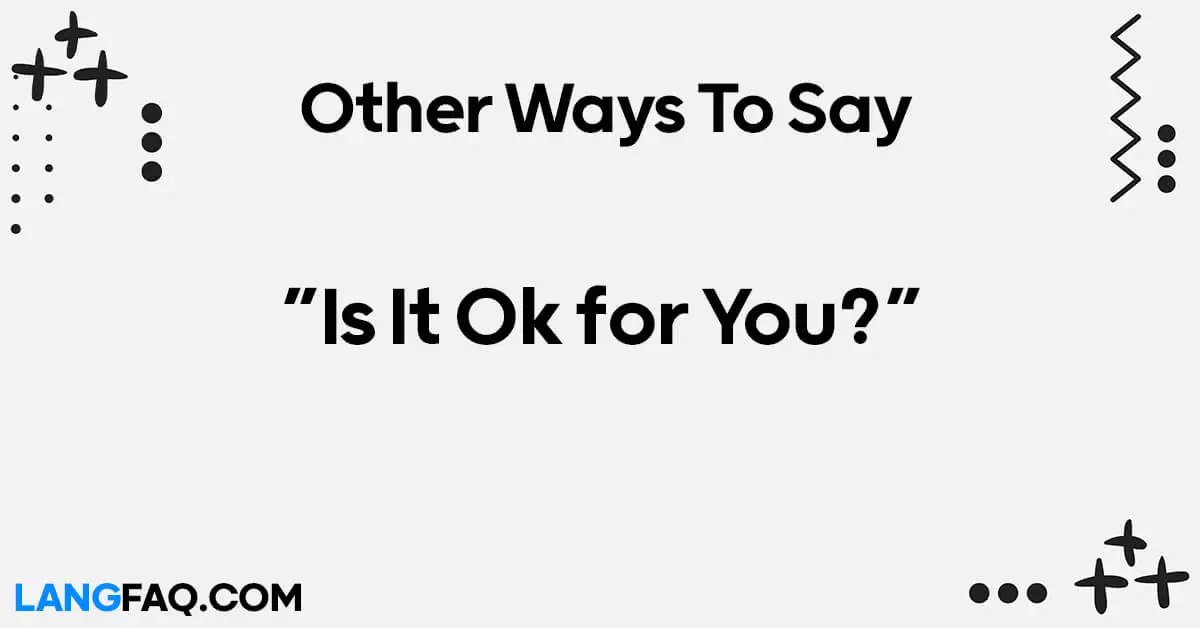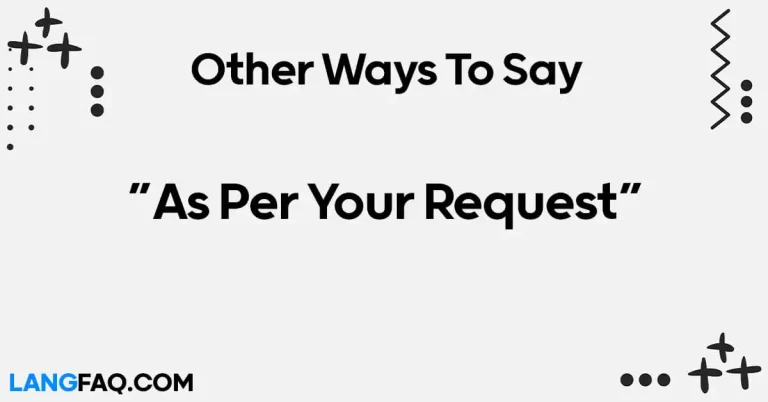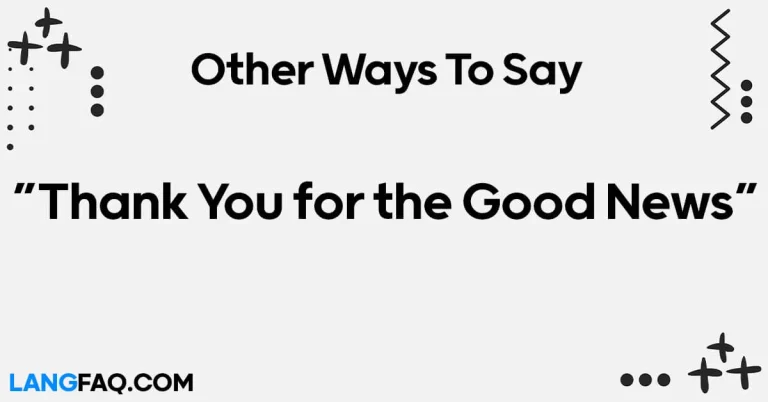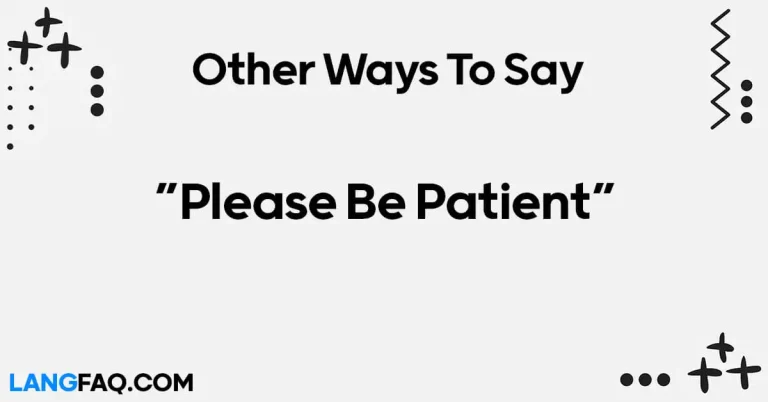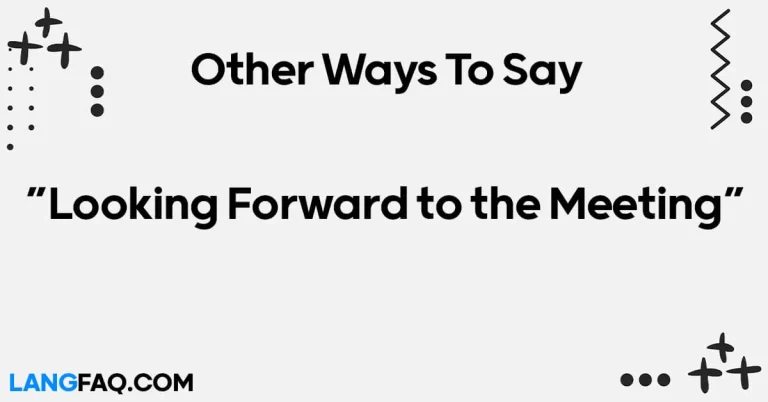In a world that values consent and open communication, finding various ways to ask, “Is it ok for you?” is crucial. This article explores diverse approaches, ensuring that seeking consent becomes a respectful and positive experience for all parties involved.
12 Other Ways to Ask “Is It Ok for You?”
Here are 12 other ways to ask “Is It Ok for You?”:
- Do you feel comfortable with this?
- Would you be alright with that?
- Is this acceptable to you?
- Do you have any concerns about this?
- Are you in agreement with this?
- Does this meet your approval?
- Would you prefer something different?
- Is this within your comfort zone?
- Are you okay proceeding with this?
- Do you have any objections?
- Is this to your liking?
- Can we move forward with your consent?
| Phrase | Meaning | Example |
|---|---|---|
| Do you feel comfortable with this? | Inquiring about the person’s comfort level or agreement. | “Before we proceed, do you feel comfortable with this decision?” |
| Would you be alright with that? | Seeking confirmation of acceptance or agreement. | “Would you be alright with extending the deadline by a day?” |
| Is this acceptable to you? | Checking if the proposal or action is acceptable. | “Is this new arrangement acceptable to you?” |
| Do you have any concerns about this? | Inviting the person to express any reservations. | “Feel free to share if you have any concerns about the plan.” |
| Are you in agreement with this? | Verifying if the person is in accordance with the proposal. | “Just checking, are you in agreement with the proposed changes?” |
| Does this meet your approval? | Seeking approval or confirmation of satisfaction. | “Please review the document and let me know if it meets your approval.” |
| Would you prefer something different? | Allowing the person to express a preference for an alternative. | “If this doesn’t suit you, would you prefer something different?” |
| Is this within your comfort zone? | Checking if the proposal aligns with the person’s comfort level. | “Let me know if this falls within your comfort zone.” |
| Are you okay proceeding with this? | Confirming the person’s readiness to move forward. | “If you’re okay, we can proceed with the next steps.” |
| Do you have any objections? | Encouraging the person to voice any disagreements or objections. | “Feel free to speak up if you have any objections to the proposal.” |
| Is this to your liking? | Inquiring if the person finds the proposal satisfactory. | “Take a look and let me know if this arrangement is to your liking.” |
| Can we move forward with your consent? | Seeking explicit permission to proceed. | “If you’re on board, can we move forward with your consent?” |
Effectively seeking consent involves employing diverse and respectful language. These phrases provide alternatives to the traditional “Is It Ok for You?” and cater to various communication styles, ensuring clarity and openness in conversations.
Is It Correct to Say “Is It Ok for You?”?
Yes, “Is it okay for you?” is grammatically correct and commonly used in everyday English. It is a polite and considerate way to inquire whether someone is comfortable or agrees with a particular situation, decision, or proposal.
Here are a few examples of how this phrase can be used:
- In a Professional Setting:
- “We’re planning to schedule the meeting for tomorrow. Is it okay for you, or do you have any scheduling conflicts?”
- In a Social Context:
- “We’re thinking of trying a new restaurant for dinner. Is it okay for you, or would you prefer a different cuisine?”
- In a Collaborative Project:
- “The team is considering a new approach for the project. Is it okay for you, or do you have any suggestions or concerns?”
- In a Personal Relationship:
- “We’re thinking of going on a road trip this weekend. Is it okay for you, or do you have other plans?”
This phrase is versatile and can be adapted to various situations, making it a respectful and clear way to seek someone’s approval or comfort.
Professional Mail Example With “Is It Ok for You?”
Subject: Confirmation of Meeting Schedule
Dear [Recipient’s Name],
I trust this email finds you well. We are in the process of finalizing the schedule for the upcoming project review meeting, and I wanted to confirm the proposed timing with you.
The proposed date and time for the meeting are [Date], [Time]. Before we proceed with locking in this schedule, I would like to confirm whether this timing is suitable for you or if you have any scheduling conflicts during that period.
Your input is crucial to ensure that all team members can actively participate in the discussion, and we want to accommodate everyone’s availability.
Please take a moment to review the proposed schedule, and if there are any adjustments needed, or if another time would be more convenient for you, kindly let me know at your earliest convenience.
Thank you for your attention to this matter, and I appreciate your cooperation.
Best regards,
[Your Full Name] [Your Position] [Your Company] [Contact Information]
1. Do You Feel Comfortable with This?
When engaging in a formal or professional context, using the phrase “Do you feel comfortable with this?” is a tactful way to gauge someone’s comfort level with a decision or action. It demonstrates respect for their well-being and ensures a positive working relationship.
Example Scenario:
In a workplace setting, you might use this phrase when suggesting changes to a project plan or workflow.
Example Sentence:
“Before we proceed with implementing the new policy, do you feel comfortable with this direction, considering your team’s workload?”
Email Sample:
Subject: Seeking Your Input on Proposed Changes
Dear [Recipient’s Name],
I hope this email finds you well. We are considering some changes to the project timeline, and I would like to get your input before moving forward. Do you feel comfortable with the proposed adjustments? Your feedback is crucial for the success of the project.
Best regards,
[Your Name]
Variations:
- Between Colleagues: “Are you comfortable proceeding with this plan, considering the team’s workload?”
- Informal Setting: “Hey, before we finalize the weekend plans, do you feel comfortable with the chosen venue?”
Insights:
- Use this phrase in situations where a decision might impact someone personally or professionally.
- Be genuinely open to their response and be prepared to discuss any concerns they may have.
2. Would You Be Alright with That?
This phrase adds a touch of courtesy and consideration to your inquiry. It’s suitable for both professional and informal contexts, making it versatile in different communication scenarios.
Example Scenario:
You can employ this phrase when suggesting changes in plans during a casual gathering or proposing alterations to a project timeline at work.
Example Sentence:
“Considering the tight deadline, would you be alright with extending the project timeline by a day to ensure quality?”
Email Sample:
Subject: Proposed Adjustment to Project Timeline
Dear [Recipient’s Name],
I hope this message finds you well. I am reaching out to discuss a potential adjustment to the project timeline. Would you be alright with extending the deadline by a day to allow for thorough quality checks? Your input is highly valued.
Best regards,
[Your Name]
Variations:
- Between Friends: “Hey, we’re thinking of changing the movie night to Saturday. Would you be alright with that?”
- Professional Setting: “Considering your workload, would you be alright with delegating this task to another team member?”
Insights:
- Use this phrase to convey a sense of collaboration and mutual decision-making.
- It’s effective when proposing changes that might impact the individual’s schedule or plans.
3. Is This Acceptable to You?
The phrase “Is this acceptable to you?” is a direct yet formal way of seeking approval. It is particularly useful in professional settings, ensuring clarity and aligning with workplace communication etiquette.
Example Scenario:
In a meeting or negotiation, when proposing terms or conditions, this phrase is apt for confirming the acceptability of the proposed agreement.
Example Sentence:
“We’ve reviewed the contract amendments. Is this acceptable to you, or would you like further adjustments before finalizing?”
Email Sample:
Subject: Confirmation of Proposed Changes
Dear [Recipient’s Name],
I trust this email finds you well. We’ve made some adjustments to the project plan based on recent discussions. Could you please review and confirm if these changes are acceptable to you? Your prompt feedback is appreciated.
Best regards,
[Your Name]
Variations:
- In Negotiations: “Before we proceed with the terms, is this acceptable to you and your team?”
- Informal Request: “We’re thinking of changing the meeting time. Is this acceptable to you and the others?”
Insights:
- Use this phrase when discussing formal agreements or changes that might impact multiple parties.
- Be clear and concise when presenting the proposal, allowing the individual to provide a straightforward response.
4. Do You Have Any Concerns About This?
Acknowledging the possibility of concerns shows empathy and encourages open communication. This phrase is suitable in various settings, emphasizing transparency and addressing potential reservations.
Example Scenario:
Before implementing a new policy or procedure, it’s valuable to ask team members if they have any concerns about the upcoming changes.
Example Sentence:
“As we transition to the new software, do you have any concerns about this migration process or potential challenges we might encounter?”
Email Sample:
Subject: Seeking Input on Transition Plan
Dear [Recipient’s Name],
I hope this message finds you well. As we prepare for the upcoming transition to the new software, I wanted to check in with you. Do you have any concerns about this migration process, or is there anything you’d like to discuss? Your insights are crucial to a smooth transition.
Best regards,
[Your Name]
Variations:
- Between Peers: “Before we finalize the travel plans, do you have any concerns about this accommodation choice?”
- Professional Inquiry: “In the upcoming presentation, do you have any concerns about the proposed data analysis?”
Insights:
- Use this phrase to create an environment where concerns are welcomed and addressed.
- Be prepared to discuss and potentially adjust plans based on the concerns raised.
5. Are You in Agreement with This?
This phrase is suitable for formal contexts where consensus or alignment on a decision is crucial. It invites individuals to confirm their agreement and ensures everyone is on the same page.
Example Scenario:
In a team meeting, when discussing strategic decisions, using this phrase helps confirm that all team members agree with the proposed direction.
Example Sentence:
“Before finalizing the budget allocation, I’d like to confirm – are you in agreement with this distribution among the different departments?”
Email Sample:
Subject: Confirmation of Strategic Decision
Dear [Recipient’s Name],
I trust this email finds you well. We’ve discussed the budget allocation in our recent meetings. Before we proceed, I’d like to confirm: Are you in agreement with the proposed distribution among the departments? Your input is valued.
Best regards,
[Your Name]
Variations:
- Project Collaboration: “Before we conclude the project plan, are you in agreement with the proposed timeline?”
- Between Partners: “Considering our plans for the weekend, are you in agreement with the choice of restaurant?”
Insights:
- Use this phrase when seeking confirmation on decisions that impact the group or project.
- Encourage open discussion if there are differing opinions to reach a consensus.
6. Does This Meet Your Approval?
Seeking approval is crucial in professional settings, especially when presenting work or proposals. This phrase adds a formal touch, emphasizing the desire for the individual’s endorsement.
Example Scenario:
Before finalizing a report or project, it’s beneficial to confirm with stakeholders whether the work meets their expectations.
Example Sentence:
“After reviewing the marketing campaign proposal, does this meet your approval, or are there specific elements you’d like us to revisit?”
Email Sample:
Subject: Request for Approval on Project Proposal
Dear [Recipient’s Name],
I hope this email finds you well. We’ve prepared the project proposal based on our recent discussions. Could you please review and confirm if it meets your approval? Your endorsement is integral to the project’s success.
Best regards,
[Your Name]
Variations:
- Within a Team: “Before presenting to the client, does the project summary meet your team’s approval?”
- Between Collaborators: “Considering the edits, does the final version of the document meet your approval?”
Insights:
- Use this phrase to explicitly seek endorsement and approval.
- Provide an opportunity for feedback and revisions if necessary.
7. Would You Prefer Something Different?
Maintaining flexibility and accommodating preferences is essential, especially in casual or informal settings. This phrase offers an open invitation for individuals to express their preferences without hesitation.
Example Scenario:
When planning an event or activity, using this phrase allows participants to voice their preferences, ensuring everyone is comfortable and satisfied.
Example Sentence:
“We were thinking of going to the beach, but would you prefer something different for our weekend getaway?”
Email Sample:
Subject: Options for Team Outing
Dear [Recipient’s Name],
As we plan our team outing, we’re considering various options. Would you prefer something different than the initial suggestions, or is there a particular activity you’d enjoy? Your input is valuable.
Best regards,
[Your Name]
Variations:
- Between Friends: “We were planning on a movie night, but would you prefer something different for our hangout?”
- Professional Inquiry: “We’ve proposed a team-building activity, but would you prefer something different for our next team event?”
Insights:
- Use this phrase when exploring options and accommodating individual preferences.
- Create an environment where individuals feel comfortable expressing their choices.
8. Is This Within Your Comfort Zone?
Acknowledging personal boundaries is crucial in both professional and personal relationships. This phrase is especially useful when suggesting activities or initiatives that might push someone outside their comfort zone.
Example Scenario:
When proposing a team-building exercise or a new project, use this phrase to ensure everyone is comfortable with the proposed tasks.
Example Sentence:
“We’re considering a more collaborative approach for the next project. Is this within your comfort zone, or do you have any reservations about this working style?”
Email Sample:
Subject: New Project Collaboration Approach
Dear [Recipient’s Name],
I trust this email finds you well. We’re exploring a more collaborative approach for the upcoming project. Before we finalize, could you please confirm if this is within your comfort zone? Your feedback is appreciated.
Best regards,
[Your Name]
Variations:
- Professional Inquiry: “Considering your workload, is this new project timeline within your comfort zone?”
- Within a Team: “We’re introducing a new software. Is this within your team’s comfort zone, or do you foresee any challenges?”
Insights:
- Use this phrase when proposing activities or changes that might impact someone’s comfort level.
- Encourage open communication about potential challenges or reservations.
9. Are You Okay Proceeding with This?
In both formal and informal situations, ensuring that everyone is comfortable moving forward is essential. This phrase is straightforward and suitable for confirming an individual’s readiness to proceed.
Example Scenario:
Before initiating a new project phase or implementing changes, use this phrase to confirm that all team members are on board.
Example Sentence:
“Before we kick off the next phase of the project, I want to check in – are you okay proceeding with this plan, or do you have any concerns?”
Email Sample:
Subject: Confirmation for Next Project Phase
Dear [Recipient’s Name],
I hope this message finds you well. As we prepare to move into the next phase of the project, I’d like to confirm – are you okay proceeding with this plan, or are there any adjustments you’d like to discuss? Your input is valuable.
Best regards,
[Your Name]
Variations:
- Team Collaboration: “Before we implement the software update, are you okay proceeding with this plan, considering your team’s workflow?”
- Casual Setting: “For the weekend road trip, are you okay proceeding with the chosen route, or would you prefer an alternative?”
Insights:
- Use this phrase to ensure everyone is on the same page before moving forward.
- Encourage individuals to express any concerns or adjustments they might have.
10. Do You Have Any Objections?
This phrase is particularly useful in professional settings where open discussion and addressing potential objections are crucial. It invites individuals to voice any concerns or disagreements they may have.
Example Scenario:
During a meeting or decision-making process, using this phrase fosters an environment where objections are welcome, ensuring thorough discussion.
Example Sentence:
“Before we finalize the budget allocation, I want to open the floor – do you have any objections or concerns about the proposed distribution among departments?”
Email Sample:
Subject: Discussion on Proposed Changes
Dear [Recipient’s Name],
I trust this email finds you well. As we finalize the changes to the project plan, I want to ensure all concerns are addressed. Do you have any objections or suggestions you’d like to discuss? Your insights are valued.
Best regards,
[Your Name]
Variations:
- Team Collaboration: “Before concluding the team meeting, do you have any objections or additional points you’d like to raise?”
- Between Peers: “Regarding the upcoming event, do you have any objections to the proposed agenda, or should we make adjustments?”
Insights:
- Use this phrase to promote open communication and address potential objections.
- Create an atmosphere where individuals feel comfortable expressing dissenting opinions.
11. Is This to Your Liking?
In situations where individual preferences or personal choices are significant, using the phrase “Is this to your liking?” is a polite and considerate way to seek approval or confirmation.
Example Scenario:
When selecting a venue for an event or proposing changes that involve personal preferences, this phrase ensures everyone is satisfied with the decision.
Example Sentence:
“We’ve curated a few options for the team-building venue. Take a look and let me know – is this to your liking, or would you prefer a different setting?”
Email Sample:
Subject: Confirmation on Team-building Venue
Dear [Recipient’s Name],
I hope this email finds you well. We’ve shortlisted potential venues for the team-building event. Could you please review and confirm if any of these are to your liking, or if you have specific preferences? Your input matters.
Best regards,
[Your Name]
Variations:
- Casual Gathering: “We’re planning a movie night. Is the movie choice to your liking, or should we consider other options?”
- Professional Setting: “Regarding the client presentation, are the visuals and content to your liking, or should we make adjustments?”
Insights:
- Use this phrase when decisions involve personal preferences or individual tastes.
- Encourage individuals to express their preferences openly and suggest alternatives if necessary.
12. Can We Move Forward with Your Consent?
Ensuring explicit permission is especially important in professional or formal settings. This phrase emphasizes the importance of consent and collaboration in moving forward with a decision or action.
Example Scenario:
Before implementing changes, launching a project, or making decisions that impact multiple parties, confirming consent is crucial.
Example Sentence:
“Considering the feedback, can we move forward with your consent on the proposed marketing strategy, or are there further adjustments you’d like us to consider?”
Email Sample:
Subject: Seeking Your Consent on Strategic Decision
Dear [Recipient’s Name],
I trust this email finds you well. We’ve incorporated your feedback into the proposed marketing strategy. Can we move forward with your consent, or would you like additional modifications? Your consent is integral to the success of this initiative.
Best regards,
[Your Name]
Variations:
- Project Collaboration: “Before we launch the new product, can we move forward with your consent, considering your team’s input?”
- Professional Inquiry: “Regarding the upcoming partnership, can we move forward with your consent, or are there specific terms you’d like to discuss?”
Insights:
- Use this phrase to emphasize the importance of collaboration and ensure everyone is aligned before proceeding.
- Be clear about the decision or action that requires consent and provide an opportunity for final input.
FAQs
What if someone hesitates? Addressing hesitation involves creating a non-judgmental space for open communication. Encourage the person to express their thoughts and concerns, ensuring that consent is mutual.
Is non-verbal consent enough? While non-verbal cues are significant, verbal confirmation adds clarity. Strive for a combination of verbal and non-verbal consent to ensure comprehensive understanding.
How to gracefully decline? Graceful decline involves expressing appreciation for the request while firmly stating personal boundaries. Communicate with kindness and assertiveness.
Conclusion
In conclusion, understanding the various ways to ask “Is it ok for you?” contributes to respectful and open communication. By navigating verbal and non-verbal approaches, cultural considerations, and professional settings, individuals can foster positive relationships and build trust. Always remember, consent is an ongoing dialogue that promotes understanding and respect.

